Silver Tree Chaser
Bronze Member
I recently found this thin piece of brass at a cellar hole site, which produced a late 19th century button and a jaw harp fragment but little else during my 1-2 hour search. At a glance, I thought that it might be a dandy button, but the brass piece was too large and oval-shaped. It was also too thin to be a belt plate, and so I figured it for nothing more than some odd piece of scrap, junk soon to be discarded. But then I noticed it had some engravings, actually some ornate lettering with a name and location – London, though it was engraved “LONDINI.” I was perplexed by the odd spelling. 
Upon returning home, some light brushing with mineral oil revealed the full engraving, “Samuel Betts, Londini.”
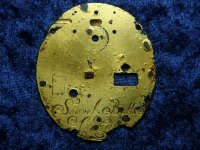
I considered that I might have found a back plate from a 19th century watch. I googled the inscription and found numerous references to Samuel Betts. It turned out that I was half right and half wrong. It was a back plate from a watch, but it dated back to the mid-1600s - 200 years earlier than what I had thought! “Londini was the spelling for London in Latin, and the earliest watches came in both round and oval shapes.
My online search showed that Samuel Betts was an important early English clockmaker who made both watches and clocks from 1640-1673. He is regarded as a great pioneer in the art and intricacies of watchmaking. His watches are in the British Museum and other notable collections. Some examples of his work are shown below with the same signature found on the dug back plate.
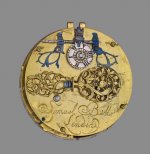
Similar signature on a Samuel Betts watch.
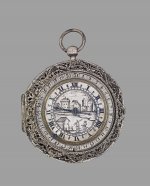
British Museum - Date - 1665-1670.
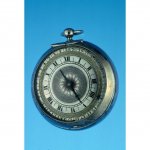
Colonial Williamsburg Collection - Date - 1665

Another Betts Watch.
We live in a remarkable age. A slight piece of engraved brass dug from a remote cellar hole offers up a clue of its past, soon revealed with a few key strokes and the click of a mouse. An online search accomplished in mere seconds traces back a history from four centuries ago – amazing!
God only knows what happened to the rest of the watch – its casing, dials, and so forth. This find is terribly incomplete, but I’m still quite happy with its recovery. It’s one of my oldest English finds, and I can absolutely connect it do a single person who lived four centuries ago; moreover, it’s a piece of metal work handmade by this one person, a master craftsman, toiling away in his workshop in 17th century London.
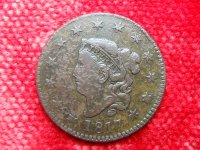
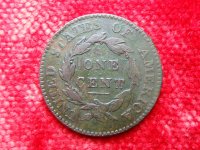
As might be expected, I made one return trip to the cellar hole in the far-flung hope of finding more of this early watch. The back plate was found along a stone wall at the end of a wagon road approximately 140’ from the cellar hole. I worked this area back & forth making runs ever closer to the cellar hole but came up with no traces of the watch. I did recover an 1817 Matron Head Large Cent in better than expected condition for a dug coin, so I didn’t go home empty-handed. I’ll get back to the cellar hole in the fall for some further searching. It’s not likely that the rest of the watch will ever be found, but you never know.
Good Hunting to All!

Upon returning home, some light brushing with mineral oil revealed the full engraving, “Samuel Betts, Londini.”

I considered that I might have found a back plate from a 19th century watch. I googled the inscription and found numerous references to Samuel Betts. It turned out that I was half right and half wrong. It was a back plate from a watch, but it dated back to the mid-1600s - 200 years earlier than what I had thought! “Londini was the spelling for London in Latin, and the earliest watches came in both round and oval shapes.
My online search showed that Samuel Betts was an important early English clockmaker who made both watches and clocks from 1640-1673. He is regarded as a great pioneer in the art and intricacies of watchmaking. His watches are in the British Museum and other notable collections. Some examples of his work are shown below with the same signature found on the dug back plate.

Similar signature on a Samuel Betts watch.

British Museum - Date - 1665-1670.

Colonial Williamsburg Collection - Date - 1665

Another Betts Watch.
We live in a remarkable age. A slight piece of engraved brass dug from a remote cellar hole offers up a clue of its past, soon revealed with a few key strokes and the click of a mouse. An online search accomplished in mere seconds traces back a history from four centuries ago – amazing!
God only knows what happened to the rest of the watch – its casing, dials, and so forth. This find is terribly incomplete, but I’m still quite happy with its recovery. It’s one of my oldest English finds, and I can absolutely connect it do a single person who lived four centuries ago; moreover, it’s a piece of metal work handmade by this one person, a master craftsman, toiling away in his workshop in 17th century London.


As might be expected, I made one return trip to the cellar hole in the far-flung hope of finding more of this early watch. The back plate was found along a stone wall at the end of a wagon road approximately 140’ from the cellar hole. I worked this area back & forth making runs ever closer to the cellar hole but came up with no traces of the watch. I did recover an 1817 Matron Head Large Cent in better than expected condition for a dug coin, so I didn’t go home empty-handed. I’ll get back to the cellar hole in the fall for some further searching. It’s not likely that the rest of the watch will ever be found, but you never know.
Good Hunting to All!
Last edited:
Upvote
47








